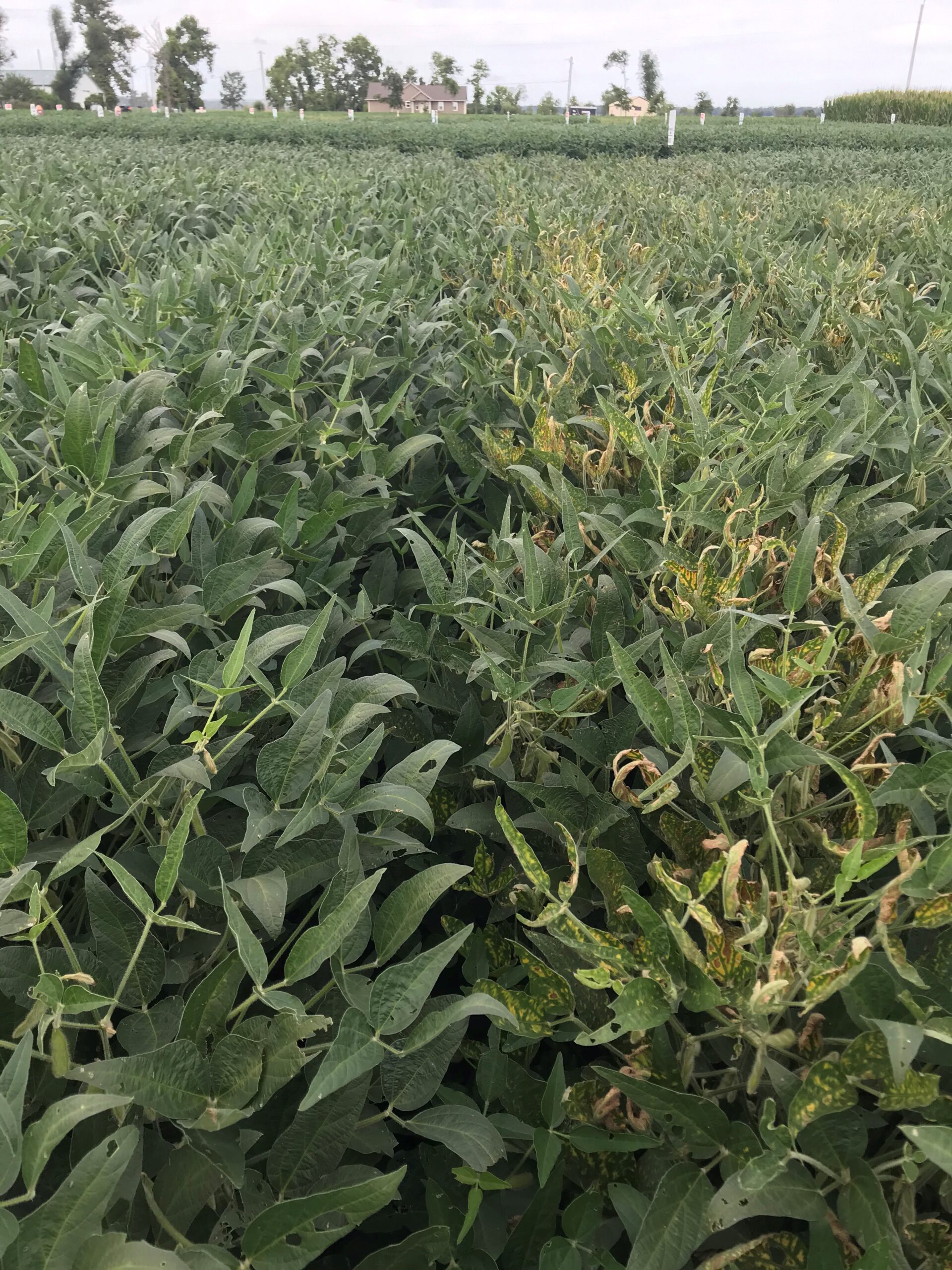For many, the arrival of September brings anticipation of school, fall sports, a variety of pumpkin flavored beverages and beautiful fall weather. In agriculture, September ushers in rapidly maturing crops and the culmination of the successes and disappointments of the 2020 season. Soybean fields beginning to turn color are an indication that harvest is fast approaching, yet yellowing or leaf senescence can be caused by a variety of agronomic issues in addition to being a natural maturation process. Let’s explore what causes soybean leaf senescence and how to identify some of the causes of premature leaf senescence.

What is leaf senescence?
In common, everyday terms, we might say that ‘a field is turning’ to indicate the progression of natural leaf color change from green to yellow, followed by leaves that drop from the plant. This process is known as leaf senescence and occurs as the soybean plant matures. Physiologically, nutrients such as nitrogen that have been accumulated in the leaf begin to move to the pods or other parts of the plant. Nitrogen is a key component of chlorophyll, the chemical compound that causes leaves to be green, so we see this process visually as leaves turning yellow as chlorophyll is degraded. As this senescence process reaches completion, leaves of some plants like corn remain attached to the plant, while others including soybeans shed their leaves.
When should soybean naturally begin senescence?
Natural leaf senescence is a complex process in plants. Several theories have been proposed to explain why senescence occurs in annual crops like soybean. One idea is that as pods reach their maximum size and begin to mature, they send some type of signal to the rest of the plant that indicates that there is no need to continue growing, and senescence begins. Green stem disorder in soybeans is a good example of how this theory may not hold true. Mature pods occurring on stems that do not mature suggest that the vegetative and reproductive parts of the plant have some capacity to function independently.
A second theory suggests that the hunger of developing pods for mineral nutrients and sugars exceeds the plant’s ability to take up adequate nutrients from the soil or to create sugars through photosynthesis. As a result, the plant begins to cannibalize itself to support the needs of the pods. This idea probably has some merit. Think about your high yield soybean plot where you have focused your efforts on supplying adequate nutrition and probably have made at least one fungicide application. Do those plants mature more quickly or mature later than soybeans that have received fewer intensive inputs? Usually, plants that have been well fed and protected from disease will have better stay-green compared to the check treatment.
A third influence on natural soybean senescence in soybeans is related to day-length. Soybeans are an example of a photoperiod sensitive crop. In other words, the length of the nighttime period affects key developmental transitions. Although we typically think about this response in relationship to soybean flowering, it probably has an equal, if not greater, influence on when senescence begins. Have you ever seen soybean plants growing under a security lamp that is on all night? Do they ever begin to turn color in the fall? Likely not, most times these plants will be killed by frost even though they may have developing pods present. Soybeans of different relative maturity groups have different photoperiods (nighttime length) that trigger physiological changes. As days get shorter and nights get longer in the fall, fields will begin to senesce based on genetic characteristics.
Causes of premature senescence
As you look out across a soybean field, is the change in color at this time of year uniform, suggesting natural senescence, or are there random areas throughout the field that seem to be senescing rapidly compared to the rest of the field? In the second half of August this year, many fields that I have driven past seem to be senescing earlier that desirable, and this rapid plant death occurs in pockets. Sudden death syndrome caused by Fusarium virguliforme has been widespread this year, and likely more prevalent due to the trend toward early planted soybeans this past spring. Other diseases like brown stem rot and red crown rot, which cause similar above ground symptomology, could also be at fault.
Many areas of Illinois have experienced dry weather over the last month or more. If areas of the field that are yellowing are also exhibiting stunting and poor pod set, this could be an indication of an area of heavy soybean cyst nematode (SCN) pressure. Although SCN is likely present in all fields, we do not often see the visual symptomology of SCN damage when weather conditions are ideal for water and nutrient uptake. As environmental stresses increase as they have in recent weeks, the conditions for significant yield loss from SCN feeding become more common. If SCN is suspected in parts of the field based on visual symptoms, it is worthwhile to record those areas so that they can be sampled after harvest for a laboratory analysis. If results indicate high levels of SCN, seed treatment nematicides should be considered as a management option for the next year that soybeans are grown in that field.
Wrap-up
While crop inputs for the 2020 growing season are past us, we can still learn a lot about our fields as harvest approaches. In particular, watching soybean leaf senescence patterns throughout a field, and determining whether they are natural or caused by stresses and pathogens can help identify needed changes in future decisions such as fertility programs, variety selection and seed treatments.




 and then
and then